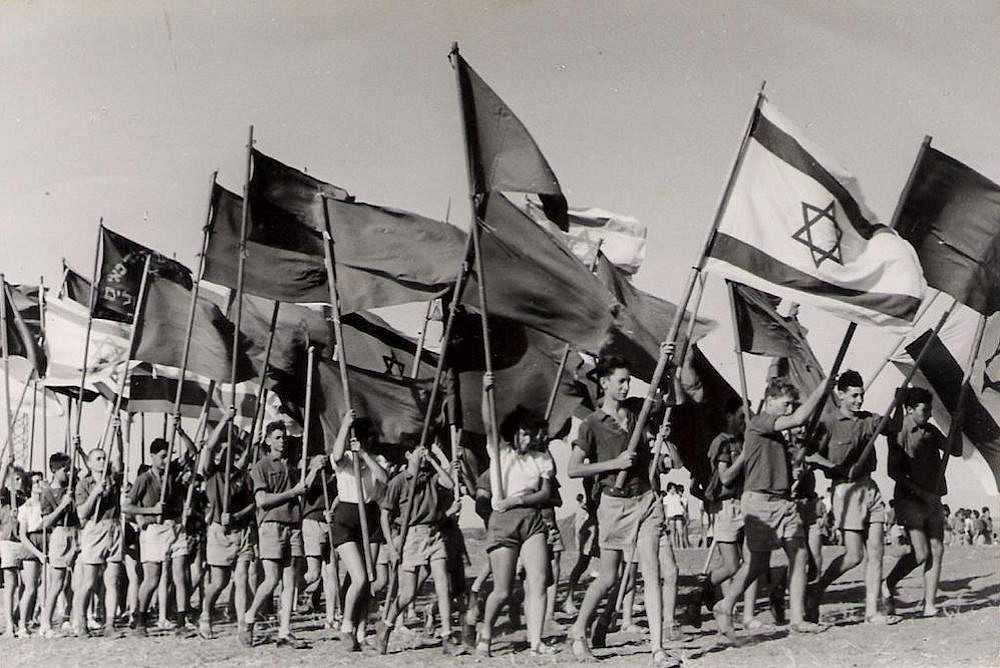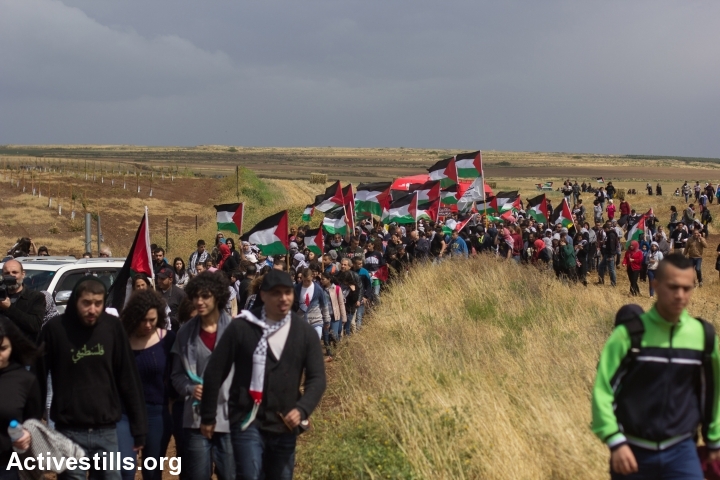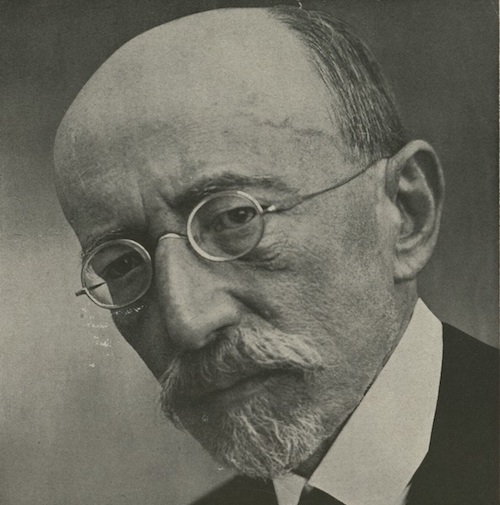For a new political imagination, Israeli Jews must unlearn Zionism
As Israelis, our task is not only to recognize the expulsion of Palestinians in 1948 — it is to train our imagination to build a shared place to live in freedom and equality.
 Illustrative photo of kibbutz ceremony, July 1951. (פוטו ארדה)
Illustrative photo of kibbutz ceremony, July 1951. (פוטו ארדה) By Norma Musih May 24, 2020
By Norma Musih May 24, 2020I moved from Jerusalem to Tel Aviv in 2001. By then, I had understood the history of the hundreds of depopulated Palestinian villages that are scattered across modern-day Israel. I knew them as national parks, as ruins along the road, as picnic sites, and as Israeli cities; some I knew by their original Arabic names.
Tel Aviv itself stands over six Palestinian localities that existed before 1948: al-Jamasin al Gharbi, al-Mas’udiyya (Summayl), al-Shaykh Muwanis, Salameh, a fisherman’s village, and the northern Jaffa neighborhood al-Manshiyya. Yet when I saw their remains, entangled with the streets, galleries, and coffee shops of Tel Aviv, I could not imagine these villages or their inhabitants becoming part of the city again.
My inability to picture such a future speaks to the overwhelming power that the Zionist national imaginary has had on my thinking. The ethos of Zionism has redrawn the land by means of partition, segregation, and discrimination, leaving no space to envision anything other than what exists today. Very few Israeli Jews, for example, have the political imagination to see themselves as equals to the Palestinians, both those with Israeli citizenship and those without.
“Imagination” does not merely belong to the realm of fantasy; it’s not something unreal that “happens” when one closes their eyes. On the contrary, it is an action that takes place when one’s eyes are. And we need imagination to understand the past, present, and future of Israel-Palestine through a lens freed from the confines of Zionism’s exclusive imaginary.
For political theorist Hannah Arendt, imagination is about the relationships that emerge between people who can see each other and envision each other’s perspectives. The force of imagination, she writes, “makes the others present and thus moves in a space that is potentially public, open to all sides… To think with an enlarged mentality means that one trains one’s imagination to go visiting.”

Arendt teaches us that the imagination is not something that “appears” as a muse to an artist or as a quality we are born with. Rather, it is a capacity that we must train. The imagination is like a muscle in the body or the ability to write or think — an ongoing process that requires practice. Through this notion, Arendt suggests developing the imagination as a tool to overcome “dark times” and generate political change.
For Israel-Palestine, I want to suggest three key practices for training our imagination to build a shared place to live in freedom and equality: unlearning Zionism; adopting an activist approach to current realities; and visualizing alternative futures.
Unlearning Zionism
For Israeli Jews, unlearning Zionism means understanding the ideology not only as a national movement but as a colonial one — in other words, understanding it through the lens of the Nakba. Among other things, this requires learning the history that is not taught in Israeli schools: the dispossession of the native Palestinian population since 1948, the expulsion of over 700,000 Palestinians, and the destruction of hundreds of towns and villages.This is not an easy move for Jewish Israelis, but it remains a necessary one.
Zionism is the central framework through which Jews have become Israelis: it is part of our upbringing and part of our most archaic collective fantasies. Yet in addition to the harms it imposes on the Palestinians, Zionism has also affected Jewish communities differently, particularly the Mizrahim (Jews with roots in the Arab or Muslim world), who did not align with the ideology’s white Ashkenazi foundations and faced decades of discrimination.
One key collective Zionist myth is expressed in the slogan “A land without a people for a people without a land.” The slogan infers that there were no communities, agriculture, or social culture in Palestine prior to the Jewish state’s establishment. It seeks to justify the Jewish claim to the land while doing away with the idea that another society has a belonging to it. This acquired blindness is very powerful, virtually erasing an entire people off the map.

Not all those involved in the Zionist movement shared this blindness. For example, the founder of “cultural Zionism,” Asher Zvi Hirsch Ginsberg, better known by his pen name Ahad Ha’am, opposed the views of Theodor Herzl, the founder of modern-day Zionism. In 1891, Ahad Ha’am wrote “The Truth about Palestine,” a report based on his visit to the country that described Palestine not as an empty land, but as a territory cultivated and inhabited by other people. Ahad Ha’am became one of the “intellectual fathers” of Brit Shalom (Alliance of Peace), a group founded in 1925 during the British mandate that advocated for a binational state with equal civil rights for Jews and Arabs.
The Zionist imaginary eventually worked to create Palestine’s mythologized “emptiness” through the expulsion of the native inhabitants, the erasure of Palestinian names from the map, and the destruction of Palestinian places on the ground. The subsequent construction of other localities with Hebrew names continued the process of forgetting the past. The Zionist imaginary often portrays this path of decimation as the sole and inevitable choice that could have been made, even though there were other early voices such as Ahad Ha’am’s and Brit Shalom’s who offered other possibilities.
In the face of these myths, perhaps the most generative role that political imagination can play in Israeli politics is to question the Zionist narrative, by training ourselves and the next generation of Israeli Jews to learn the history of the Nakba in Hebrew and in Israeli schools.
Acting in the present, visualizing alternatives
To shift our thinking about political imagination not as an individual mental activity but as a collective action, we must understand the acknowledgment of the Nakba and the taking of responsibility for this memory as a performative action. An example of this practice is the work of Zochrot (Hebrew for “we remember”), which promotes recognition of and accountability for the Nakba among Israeli Jews.One of Zochrot’s chief activities is to lead tours to the ruins of depopulated Palestinian localities, which initially began as a way of telling Israeli Jews the silenced story of the Nakba. But as the tours went on, and more testimonies from Palestinians and Israelis accumulated, Zochrot activists understood that the Nakba is not only a Palestinian memory, but a shared one. It is the memory of a common past that holds multiple, intertwining relationships between Jews and Arabs, which range from amicable neighborliness to atrocities and destruction.
There is still, of course, a strong distinction between memory and suffering. The principal suffering was and still is Palestinian; they are the ones who lost their homes, land, and freedom. But the memory also belongs to the perpetrators of this suffering; Israeli Jews who committed the atrocities, stood by and watched them, or who cheered Zionism’s mission. To this day we, Israeli Jews, enjoy the fruits of those events. As such, both Israelis and Palestinians share this memory as victims and perpetrators, not as equals parts. Thus this memory belongs to both groups, and it forms part of our shared history that cannot be told separately from each other.

A third practice for training the imagination is visualizing alternatives for the future. This means creating alliances between different groups in Israeli and Palestinian societies, rethinking policies, and developing detailed plans and strategies to challenge “the way things are.” This kind of deliberative exercise makes seemingly impossible scenarios a real possibility, key among them being the right of return for Palestinian refugees.
The Palestinian right of return, which is established in the UN Declaration of Human Rights, challenges the very core assumptions of the Zionist national imaginary. Usually, when the notion of “return” is raised in Hebrew discussions, it effectively closes the conversation. The very idea of it evokes a deep political fear, demonstrating the limits of the Israeli Jewish imagination.
Israel’s denial of the Palestinian right of return since 1948 has been articulated in Israeli public discourse as a demographic threat that will lead to a second exile, or even a second Holocaust, of the Jewish people. This notion finds its expression in the popular Israeli warning that “the Arabs will throw us [the Jews] into the sea.”
These political fears manifest themselves through a myriad of ways – from the contours of Israeli academic debates, to its legal system, to government policies and legislation. This fear is actively mobilized to justify and continue the negation of the right of return, as well as the banality of everyday evils committed by Israelis against Palestinians.

This collective fear, however, could be mitigated if Jewish Israelis think together with Palestinians about how the return of Palestinian refugees could be implemented in practical terms; that is, to plan for the “day after” from early on. This includes retracing maps of pre-1948 Palestine, planning for the construction of new homes, villages and cities, integrating the Arabic and Hebrew languages into public life, redesigning the education systems, and creating new work opportunities.
A shared imagination
Both the Israeli and Palestinian publics need to exercise their political imagination to connect their history and memory to the here and now. Our political imagination must ask: what could have happened if Palestinians had not been expelled from their homes and were allowed to come back?Activism requires learning from past mistakes, navigating obstacles and possibilities, and finding common ground among different groups. The coronavirus pandemic is an apt example of how this can emerge. Historically, pandemics have often forced societies to break with the past and imagine their world in a different light; the current pandemic has the same potential in Israel-Palestine. The coronavirus does not care for the walls or checkpoints separating Palestinian and Israeli communities, and has revealed the depths of our dependency on one another.
There are glimmers of hope despite the mounting challenges during the pandemic. For example, a small but growing number of Israeli citizens are recognizing their responsibility for the Palestinians’ depleted health care system in the occupied territories; one group launched a crowdfunding campaign to buy medical supplies for Gaza, exceeding its goal by 550 percent.
The spread of the virus demonstrates our ability to change the way we act and the way we relate to each other, including by redefining our imagined community, our “we.” We can change our habits and routines, and can change our political priorities. We should not return to “the way things were before” — a perverted reality of violence and dispossession. A shared imagination can guide us through it.

No comments:
Post a Comment
Note: only a member of this blog may post a comment.